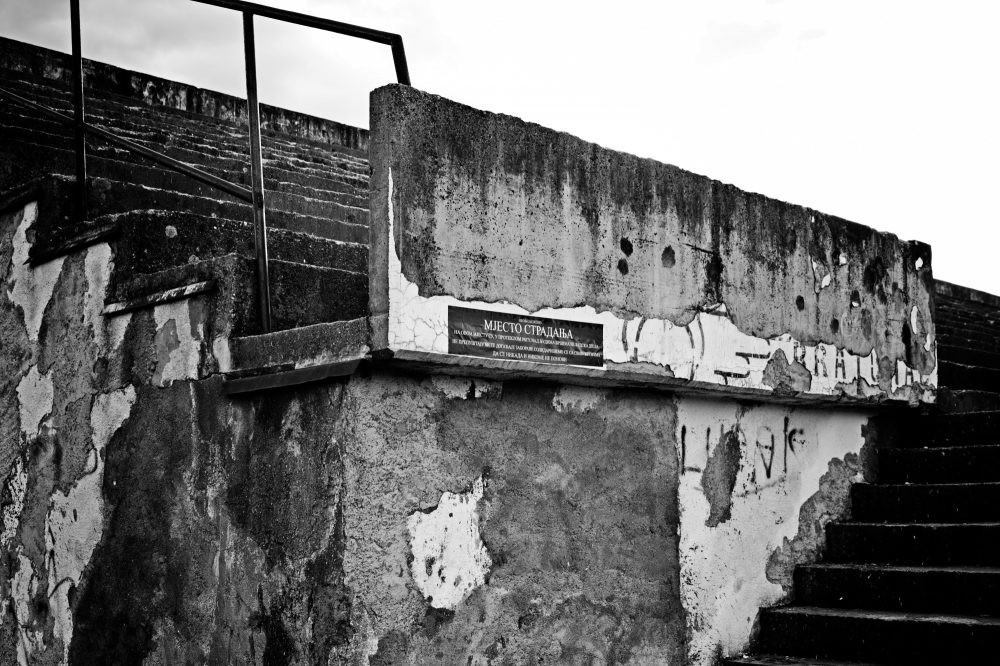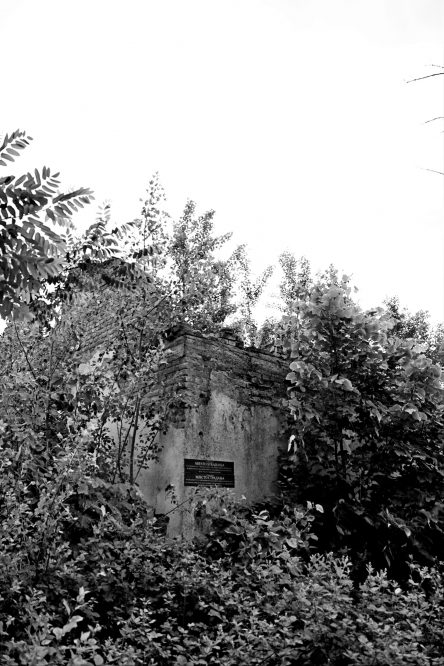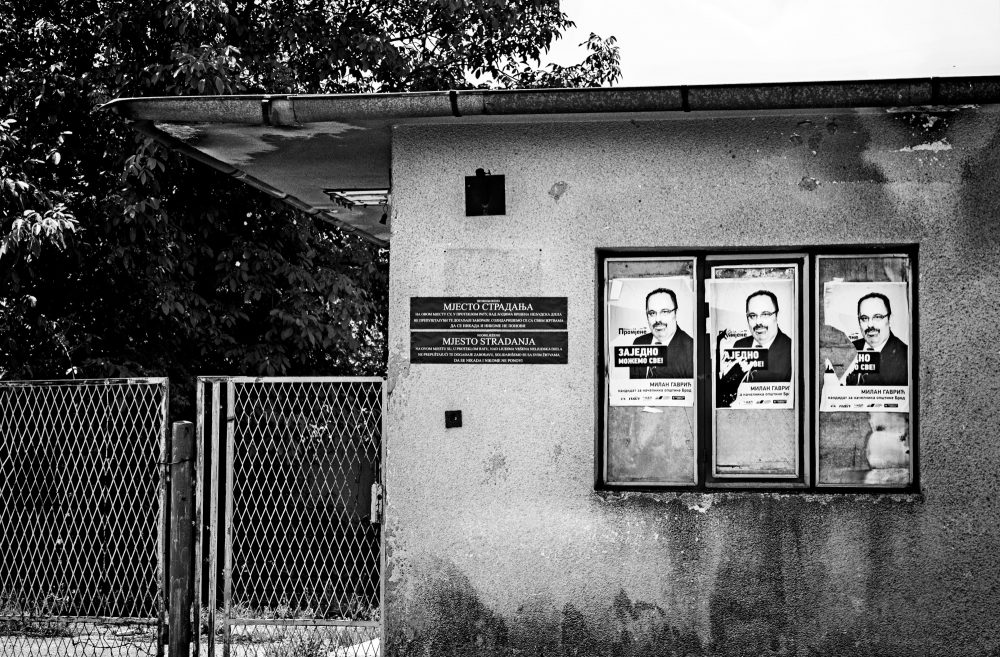We have completed another action to mark unmarked sites of suffering, our fifth, and in this action we decided to mark sites of suffering in Derventa, Brod, Zavidovići, Bratunac and Pale. Our aim was to visit and mark sites of deaths and human suffering that are not sufficiently marked or recognised. This is a way to point out their existence and invite the local residents and representatives of local communities to adopt a fairer approach to these sites of suffering.
On the first day, we arrived in Posavina and were welcomed by our host in Derventa, Spasoje Kulaga, a disabled war veteran, who would accompany us as we visited sites in the Derventa and Bosanski Brod area. From March to October 1992, Derventa was under the control of Croat forces, the HVO and HV. In that period, the authorities established prison facilities for Serbs from Derventa who had remained in town or were captured in clashes. We planned to visit a number of sites, the first being the former JNA (Yugoslav National Army) warehouse, now owned by the OS BiH (BiH Armed Forces) in Rabić. Since it is still a military facility in active use, when we approached the guard at the gate to ask about photographing the hangars, former sites of detention, she directed us to her superiors. They told us that due to the specific use of the hangars at present, it is practically impossible to receive permission to access the facilities and photograph them, even if we had filed a request with the Defence Ministry. They kindly asked us to vacate the premises under their control, which we did…
The second location according to our plan was the Silos in the village of Polje. After the war, this facility was privatised and the current management is not cooperative when it comes to memorialisation. At the gates to the Silos we asked whether we could come in and take photographs. The guard consulted with the head of security and gave us a decisively negative answer, asking us to leave the private estate.
Because the facility is located in an open outdoor area, we decided to move away from the gate and try to take a wide shot of the building. However, a security guard soon showed up to very authoritatively and decisively tell us to get lost and stop taking photographs, without further discussion. In an effort to avoid conflict, we continued on towards Brod.
In Brod, we planned to mark the sites of the GIK Warehouse (construction industry conglomerate), the Kayak Club and the Bosna Hosiery Factory. We marked all the locations with a few curious glances directed our way. The situation here is specific, because this is a Serb majority town where sites of suffering of Serb victims have been left unmarked. After marking the sites, we were supposed to meet people from the local community, namely the president of the VRS Veterans Organisation from Brod, in order to present our activities, but unfortunately he cancelled our meeting due to other engagements.
Nakon aktivnosti u Brodu, u Derventi smo održali sastanak sa predsjednikom Udruženja ratnih zarobljenika opštine Derventa Dragom Kneževićem, koji nam je dao podršku za inicijativu, ali nam i prenio svoja traumatična logoraška iskustva. On nam je također, otkrio i još jedno neobilježeno mjesto stradanja, Osnovnu školu Poljari, koja je tijekom 1992. služila kao mjesto zatočenja osoba srpske nacionalnosti.
After our activities in Brod, we returned to Derventa and had a meeting with the president of the Association of Prisoners of War from the Derventa Municipality, Drago Knežević, who expressed his support for our initiative and told us about his traumatic prisoner of war experiences. He also revealed to us another unmarked site of suffering, the Poljari Primary School, which served as a place of detention for Serbs in 1992.
After the meeting, we decided to look for the Poljari Primary School. We turned off the main road and drove on macadam for kilometres through deserted and destroyed villages, which we later learned used to be populated by Croats before the war. Of the myriad houses in ruins, none seemed to resemble a village school. Fortunately, we happened upon the local Catholic cemetery in front of the renovated church where we met the person responsible for upkeep of the yard who directed us to go back a few kilometres to an overgrown elevation. There we found a real jungle obscuring the ruins of the Poljari Primary School behind it.
We marked the site and with darkness slowly setting in, we left full of impressions.
We started the second day of our action in Zavidovići where our companion was Asim Parlić, a war veteran and retired ARBiH officer. Our prior research revealed the existence of two sites of suffering in the territory of this municipality that were still unmarked. The first was located on the so-called “13th kilometre” along the Gostović river and was the site of the foreign fighters encampment of the El-mudžahedin unit during the war. The encampment was the site of abuse, executions, even decapitations of captured members of the Republika Srpska Army. The location is deserted and only the buzzing of the bees from a nearby apiary disturbed the silence of nature and our mission. The remains of torn down buildings can be seen. Concrete and brick debris was dumped into the nearby stream.
After marking the “13th kilometre”, we continued towards the Franjo Herljević Hunting Lodge, built during the SFRY period to host high-ranking party officials who, the story goes, were even known to arrive there by helicopter. It acquired a different purpose in the war and served as a prison facility run by the VRS for detaining Bosniaks during 1992. It was also the site of abuse and beatings.
After marking the unmarked sites of suffering in Zavidovići, we met with representatives of the local authorities, the mayor’s assistant for disabled veterans Asim Karajbić and the president of the Zavidovići Municipal Council Redžo Seferović. Both expressed their support, with the Municipal Council president telling us we were heroes in his eyes, because our actions were working towards a better future.
The next site of suffering we wanted to mark was located at the other end of the country, so we set off on our way. The traumatic Podrinje and Bratunac, where we planned to mark the site of the town stadium, are unfortunately synonymous with crimes and suffering. In the spring of 1992, the Bratunac stadium was a detention site for more than 5000 Bosniaks from the Bratunac area who were abused and robbed there, and according to court records, some were killed at the site.
The third day of the action was set aside for the “loose ends” we left behind. Namely, in our previous action, we made a terrible mistake and marked the wrong building in Pale. We subsequently identified the right location of the “old” Cultural Centre in Pale where, according to multiple judgements of the ICTY (International Criminal Tribunal for the Former Yugoslavia) and domestic courts, war crimes had been committed. We had to remedy our mistake, so this time, with a good dose of fear and adrenaline, we marked the correct site of suffering.
We returned from the action empowered by the support of the people we met, but also tired and still processing our impressions of the sheer number of sites of suffering in BiH. Every corner of our country is marked by somebody’s tear, blood and suffering. Too many such sites are still concealed or kept inaccessible, and too few receive a fair and constructive approach. Although we have marked 38 sites across BiH to date, we still feel like we are only at the beginning and that we are taking on the responsibility for something that the whole of society should be doing. Remembering.


